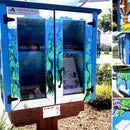Introduction: 3-D Printed Solar System Bracelet (Using Tinkercad)
This is my first 3-D printed project.
I've really wanted to try 3-D printing for a while, and outer space seemed like this nerd-girl's perfect impetus. And, since learning Tinkercad was going to use enough grey matter for one project, I decided to create a bracelet with eight 3-D printed planet links (plus Pluto!). At least the bracelet assembly shouldn't have much learning curve.
As I write this intro, my link files are out to the printer (unless I win one, I don't see a home 3-D printer in my near future). I really hope the vision in my head, and on my computer, matches the finished pieces. Either way, I'll pass along what worked, what didn't work, and what I learned. So, here I boldly go...
Step 1: What You Need
Tinkercad
3-D printer or a printing service (I used a service)
Assorted colors of nail polish
Clear nail polish
25 assorted 3-5mm jump rings
1 6-8mm bead for Pluto
1 1.5" head pin
2" unfinished chain (2-4mm links)
1 6-9mm lobster claw clasp
Jewelry making pliers (if you have)
Step 2: Building a Solar System
Planet reference.
You can use mine or find something you like better. I sketched out how I want the links to look and the (sort of) relative sizes of the planets to one another. Having made a lot of jewelry, I knew I didn't want planet diameters larger than 25mm or smaller than 10mm or the bracelet would be the wrong size. I'll use my reference material for painting as well.
You'll notice my original sketches have loops that protrude. I was concerned these would make the bracelet too large and changed to holes that run through the planets. Now that I'm thinking about it again, I could have made holes that ran straight through the links. I'll pass judgment when I see how my links come out from the printer.
I'll also decide whether there's room for Pluto and moons once I'm in assembly mode.
Note: The holes worked fine, but were awkward. I'll try another run with channels straight through if I make these again.
Note on Pluto: I decided this will be my extender, since it belongs in our solar system, but isn't a planet.
Step 3: Tinkercad.com
If you haven't used Tinkercad before, set up an account. It's easy and free. I also recommend doing the tutorials to learn the basics. If you already know how Tinkercad works, just get started.
Create a new project.
Using the shapes menu, make a half-sphere. Adjust the diameter to 25mm.
Step 4: Turn the Sphere Into a Link
Using the tube shape, create a channel through the side of the dome by inserting a tube halfway. Make it at least 2-3mm so a jump ring can later be threaded through. Set the tube to hollow.
The tube must be offset from the base at least a couple of millimeters and large enough to run a piece of wire through. Bonus points for having the channel be perfect for a jump ring. Since this is my first 3-D project, I'll be happy with just a wire.
Duplicate the tube and put another exactly opposite the first one.
Note Update: I was able to use jump rings on my finished printed links!
Step 5: Scale and Repeat
When you have your first dome with channels, go back to your sketch.
Duplicate the first link and scale it down to the next smaller planet. I went from 25mm to about 20mm. Then repeat the process for all the planets. I made 2 of the planets 15mm and two 12mm of the planets, so there's no need to make 8 different sizes.
Remember you need to end up with 8 links per bracelet.
NOTE:I made 3 sets because I needed plenty of room for experimentation.
Step 6: The Rings of Saturn
Originally I was going to put rings on Saturn and Uranus, but decided to do only Saturn. Maybe next time, Uranus.
To add rings to your Saturn dome:
Begin with the round roof shape. raise it a few millimeters larger around than the Saturn link. Then compress the width to a couple of millimeters. Center the ring over the planet and rotate so the ring is angled, but doesn't touch the tube channel.
Adjust Saturn's ring until it looks good to you. I didn't want it too big since the bracelet could get overly bulky.
Note: If you decide to make rings for Uranus, orient them straight up and down.
Step 7: Order and Wait Anxiously
Export your file and print. I used a service through 3dhubs.com and now will just wait until the pieces show up.
NOTE: I used a cheap plastic option in white.
Note Update: Wish I'd gotten a more heat resistant plastic so I could use embossing powders more easily.
Step 8: Unboxing a Solar System
My 3-D printed pieces have arrived!
Since I ordered three sets, the first thing I did was to separate them out and make sure I had all my pieces. Then I lined my planets up according to my chart and started working with one set. I also ran a wire through several of the holes to make sure they came out right. Fortunately they all went through completely.
My first Tinkercad 3-D printed project was a success!
Step 9: Close Up of Saturn
You can clearly see the holes here. It turns out they are big enough for jump rings.
Step 10: Organize the Planets
Take a piece of tape about 9 inches long and place your planets on it, in order, sticky side of the tape to the bottoms of the planets.
Step 11: Prepare Planet Links
Check all of your planet links and make sure they have no sharp edges or bits of plastic sticking out. If you find any imperfections, sand them lightly with a nail file or fine sandpaper.
Note: The next set I make I will also buff off the marks on the spheres that came as a result of the 3-D printing process.
Step 12: Begin Coloring Planets
I experimented with three ways of coloring my planets and finally settled on nail polish being the best choice. (The other two were colored pencil, and embossing powder.)
Step 13: Paint a Solar System
Get out your solar system pictures to use as a guide for patterns and color.
Remember, most illustrations that you will find are interpretations of the way planets look, so your interpretation and painting will be just as valid. Have fun with it : )
Use the transparency of the nail polish to create striped and swirl effects. You can also mix polishes together while they are wet.
Note: I used clear, gold, dark red, teal, two shades of blue, and white.
Step 14: Keep Painting
You’ll probably need at least three layers of polish to get the color and affect you want for each planet.
End with one or two coats of clear.
Step 15: Check Them Out
When your planets are dry, put them in order and look at them. Do they look like our solar system yet?
If so, allow the nail polish to dry completely - overnight if possible.
Step 16: Waiting...
Cosmic interlude.
Step 17: Add Jump Rings
Find the right sized jump ring for each planet. I did this through trial and error for each planet.
Twist one jump ring open. Guide the ring through one hole in the planet link until it comes out the hole right next to it. Close the jump ring by putting the two ends back together. This sounds like a simple process, but was actually fussier than I thought it would be. Be patient working the rings through the holes. If they don't go all the way through, you can bend them to fit and use some glue if necessary.
Step 18: Complete One Planet
Repeat by adding another ring to the holes on the opposite side of the planet link.
Step 19: Complete the Rest of the Planets
You might need to use different sized rings for the different sized planets. More trial and error. I needed three different sizes.
Put links on the rest of the planets.
Step 20: Bare & Painted
Step 21: Assemble the Solar System
Using 4 to 5 mm jump rings, you will hook all the planets together.
Start with one jump ring and twist it open. Pick any two planets that are next to each other and link them together with the jump ring. Close the ring.
Make sure all your planets are facing in the same direction.
Step 22: Complete Planet Assembly
Link all eight planets together in this manner.
Add one extra jump ring to each end.
You can try the bracelet on for size at this point.
Step 23: Time to Add Pluto
Cut a couple of inches of chain with 2-4mm links, or make a small chain with jump rings. Set aside.
Put Pluto (an 8 mm bead) on a 1.5” head pin. Make a wrapped loop as described in step 6 of this link. Before securing the loop, add Pluto to one end of your chain.
Note: This piece will be the bracelet extender.
Step 24: Pluto Extender
Add the other end of the chain to the last jump ring on one end of your bracelet, preferably next to Neptune.
Step 25: Clasp
On the jump ring at the other end of the bracelet, add a lobster clasp (that will fit through the chain links). This will allow you to adjust the bracelet’s size.
Step 26: Another Cosmic Interlude
Step 27: Optional
Add a final heavy coat of clear nail polish to all the planet links. No need to add polish to Pluto if the bead is already shiny.
Let it dry for a few hours.
Step 28: Happy With the Result
Step 29: Your Solar System Is Ready to Wear!
If you try this 3-D solar system bracelet, have fun!
I'd love to hear how it goes, and see photos.
And if you enjoy my tutorial, like the pictures, or just appreciate the effort, please vote : ) Thanks!!

Judges Prize in the
Space Challenge

Participated in the
Pocket-Sized Contest

Participated in the
Trash to Treasure













